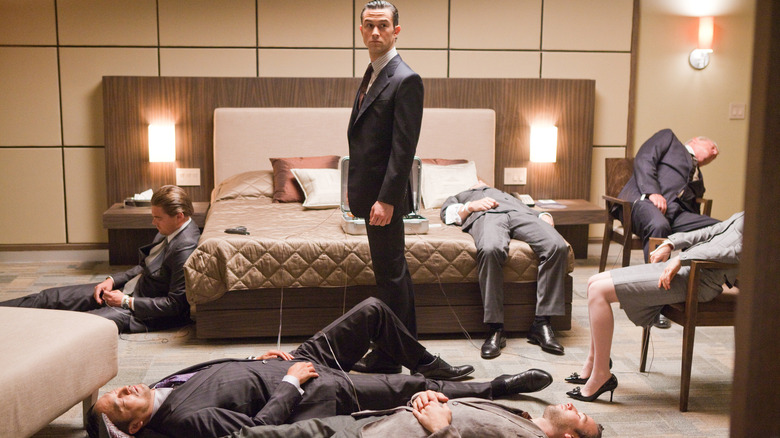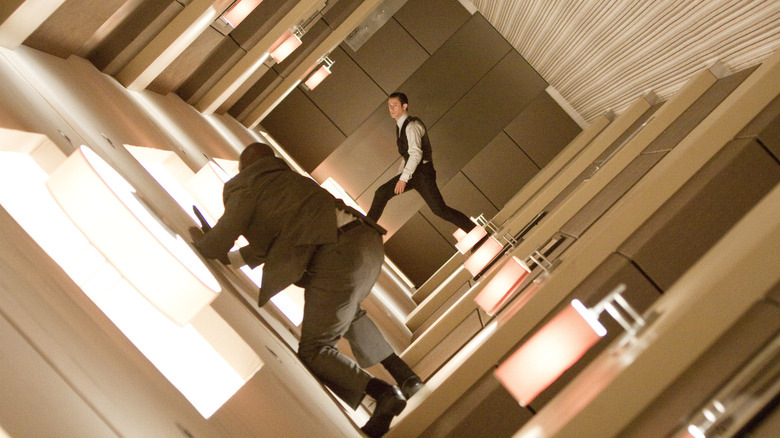Inception's Hallway Fight Is The Best Action Scene Ever
(Welcome to Best Action Scene Ever, a column dedicated to breaking down the best, most effective action sequences throughout the genre. In this edition, the impending release of Christopher Nolan's latest blockbuster has us looking back at arguably the greatest set piece he's delivered previously: the hallway fight in "Inception.")
Leave it to Christopher Nolan to take a relatively simple concept — a heist film — and turn it into one of the most mind-bending mainstream blockbusters of the century. Don't ask me why, but it's become somewhat passé in recent years to admit that a movie as complex as "Inception" actually did throw us all for a loop back in 2010, inciting an entire phenomenon of moviegoers going back to the theaters for multiple re-watches to better understand what actually happened in the story. But over a decade later, even after later efforts explored such ideas as "temporal pincer movements," there's still something magical about the depth and breadth of layers contained within "Inception."
Of course, the irony is that this is the movie in Nolan's entire filmography that spends the most amount of time outright explaining to audiences everything that's going to follow. Such intricate world-building meant getting viewers up to speed on the concepts of "kicks," dreams within dreams, and a whole lot more. But as tedious as all that exposition could've been, Nolan expertly weaved that information into the fabric of the story so that we could hit the ground running once Cobb (Leonardo DiCaprio), Ariadne (Elliot Page), Arthur (Joseph Gordon-Levitt), and the rest of the merry team of mind-thieves delved further into the subconscious of their target, businessman Robert Fischer (Cillian Murphy).
All that attention to detail allowed the hallway fight to hit harder than any Nolan action sequence had done before — or since.
The scene
One dream layer? That's easy enough to follow. But two? That's when things start getting real weird. After Cobb leads his team into Fischer's subconscious and stages a daring kidnapping attempt on their target, matters quickly fall apart when their bankrolling benefactor Saito (Ken Watanabe) is injured and various security forces end up hot on their tail. With no other choice but to forge onwards, Arthur dreams up a hotel dream layer to further convince Fischer to assist them in, essentially, breaking into his own mind. Left behind while the rest of the team advances to the third level, Arthur's main responsibility is to set the explosive charges to deliver the "kick" that will wake the team back up to the first level while dodging whatever security comes his way.
Inevitably, the situation begins deteriorating right from the jump. In the previous level, chemist Yusuf (Dileep Rao) is tasked with getting behind the wheel of the getaway van carrying all his dreaming teammates ... which is complicated by Fischer's security forces chasing him down and forcing him to resort to some seriously sloppy driving. Those effects manifest in stunning fashion in the hotel, where Arthur is beset by his own enemies in the claustrophobic confines of the hallways and rooms. Once it's clear a fight can no longer be avoided, Nolan unleashes one of the most eye-popping and utterly thrilling sequences we've ever seen him attempt.
Why it works
At this point in his career, Nolan had learned some pretty valuable lessons. While hand-to-hand fisticuffs might not be considered his biggest strength, the filmmaker innately understood the time-honored principles of what makes audiences invested in action in the first place. Coming up with evocative and original ideas — like flipping a tractor trailer end over end or setting a fight sequence in a revolving hallway — is only half the battle. You still need to do the hard work of driving up the stakes and tension to the extent that the hero's success or failure directly impacts the plot.
That's where the inherent intricacy of the plot comes into play. While a fight with two random henchmen might not loom all that large to the story in and of itself, the reverberations from the previous dream layer and the effects Arthur's actions have on the next (where Cobb, Fischer, and the rest of the dwindling team engage in their James Bond-like assault on a snowy fortress) makes this stand out as one of the pivotal moments in the entire film. Suddenly, even before the walls start turning and gravity is completely upended when Yusef's van flips over in the prior dream layer, this one sequence takes on incredible amounts of narrative importance.
Of course, it helps that the staging and choreography are so well-defined, too. Nolan's religious fervor for practical filmmaking made the fight even more visceral, all while Hans Zimmer's deafening score blares overhead. But it's the use of space and geography that makes this even more effective, turning an otherwise nondescript location into a maze of inconvenient obstacles and unexpected bursts of creativity as the editing by Lee Smith brilliantly translates every beat of the van chase into motion in the hallway fight.
The key moment
The key tenet of any heist film is that, after explaining the plan in meticulous detail, something has to go woefully wrong and throw everything on its head. In this middle portion of "Inception," Yusef's improvisation amid a shootout on the bridge means he has to enact the "kick," or that feeling of vertigo precipitating a fall that jolts a sleeping person wide awake, much too early. Initially, the team accounted for the van hitting the barrier of the bridge. But when they miss that window and the van enters freefall, causing the utter lack of gravity inside the hotel layer, Cobb and his friends must scramble once again to be ready for the next kick — the van hitting the water below.
In the space of only a few minutes, Nolan turns a series of rather indulgent action sequences — the van chase, the hotel fight, and the snowmobile assault — into a problem in need of a genuinely clever solution. As Arthur himself explained to Ariadne earlier in the film as he was setting the charges, how would he ever hope to instigate a kick without gravity? Once that worst-case scenario rears its head, he goes about setting up explosive charges around the hotel elevator. Without so much as a word of exposition, it's clear to audiences that once Cobb and his team in the snowy level accomplish their all-important mission of helping Fischer achieve his emotional realization and dissolve his company, several chain reactions will unfold that can only take place with Arthur's fast-thinking.
What we're ultimately left with is a series of immensely satisfying payoffs when each kick successfully works as planned. And at the centerpiece of all this action was an unassuming hallway fight that Nolan transformed into something much more.


